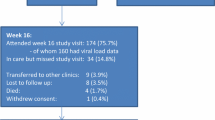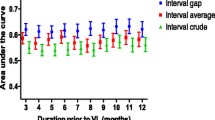Abstract
We compared multiple pharmacy refill-based adherence indicators for antiretroviral therapy, as well as thresholds for defining non-adherent behavior, based on ability to predict virological failure. A total of 29,937 pharmacy visits with corresponding viral load assessments were contributed by 8,695 patients attending a large clinic in Johannesburg, South Africa. Indicators based on pill coverage and timing of refill pickup performed comparably using the strictest thresholds for adherence [100 % pill coverage: odds ratio (OR) (95 % confidence interval (CI)) : 1.26 (1.15, 1.39); prescription picked up on or before scheduled refill date: 1.27 (1.16,1.38)]. For both types of indicators, the association between non-adherence and virological failure increased as the threshold defining adherent behavior was lowered. All measures demonstrated high specificity (range 84–98 %), but low sensitivity (5–19 %). In this setting, patients identified as non-adherent using pharmacy-based indicators are likely correctly classified and in need of interventions to improve compliance. Pharmacy based measures alone, however, are inadequate for identifying most cases of nonadherence.
Similar content being viewed by others
References
de Garcia Olalla P, Knobel H, Carmona A, Guelar A, Lopez-Colomes JL, Cayla JA. Impact of adherence and highly active antiretroviral therapy on survival in HIV-infected patients. JAIDS. 2002;30(1):105–10.
Kredo T, Walt J, Siegfried N, Cohen K. Therapeutic drug monitoring of antiretrovirals for people with HIV. Cochrane DB Syst Rev. 2009; 8(3): Article Number CD007268.
Lima V, Harrigan R, Murray M, et al. Differential impact of adherence on long-term treatment response among naive HIV-infected individuals. AIDS. 2008;22:2371–80.
Palella FJ, Delaney KM, Moorman AC, et al. Declining morbidity and mortality among patients with advanced human immunodeficiency virus infection. N Engl J Med. 1998;338:853–60.
Bangsberg DR. Preventing HIV antiretroviral resistance through better monitoring of treatment adherence. J Infect Dis. 2008;197(Suppl 3):S272–8.
World Health Organization. Patient monitoring guidelines for HIV care and antiretroviral therapy (ART). Geneva: WHO; 2006.
McMahon JH, Jordan MR, Kelley K, et al. Pharmacy adherence measures to assess adherence to antiretroviral therapy: review of the literature and implications for treatment monitoring. Clin Infect Dis. 2012;52(4):493–506.
Grossberg R, Gross R. Use of pharmacy refill data as a measure of antiretroviral adherence. Curr HIV/AIDS Rep. 2007;4:187–91.
Hess LM, Raebel MA, Conner DA, Malone DC. Measurement of adherence in pharmacy administrative databases: a proposal for standard definitions and preferred measures. Ann Pharmacother. 2006;40:1280–8.
Grossberg R, Zhang Y, Gross R. A time-to-prescription-refill measure of antiretroviral adherence predicted changes in viral load in HIV. J Clin Epidemiol. 2004;57:1107–10.
Fox M, Maskew M, Macphail AP, et al. Cohort profile: the Themba Lethu Clinical cohort, Johannesburg, South Africa. Int J Epidemiol. 2013;42(2):430–9.
Westreich D, Cole SR, Nagar S, Maskew M, van der Horst C, Sanne I. Pregnancy and virologic response to antiretroviral therapy in South Africa. PLoS ONE. 2011;6(8):e22778.
Mills EJ, Nachega JB, Buchan I, et al. Adherence to antiretroviral therapy in Sub-Saharan Africa and North America: a meta-analysis. JAMA. 2006;296(6):679–90.
Riddler S, Haubrich R, DiRienzo AG, et al. Class-sparing regimens for initial treatment of HIV-1 infection. N Engl J Med. 2008;358(20):2095–106.
Westreich D, Cole SR, Funk MJ, Brookhart MA, Sturmer T. The role of the c-statistic in variable selection for propensity score models. Pharmacoepidemiol Drug Saf. 2011;20(3):317–20.
El-Khatib Z, Ekstrom AM, Coovadia A, et al. Adherence and virologic suppression during the first 24 weeks on antiretroviral therapy among women in Johannesburg, South Africa- a prospective cohort study. BMC Public Health. 2011;11:88.
El-Khatib Z, Ekstrom AM, Ledwaba J, et al. Viremia and drug resistance among HIV-1 patients on antiretroviral treatment: a cross-sectional study in Soweto, South Africa. AIDS. 2010;24:1679–87.
Ross-Degnan D, Pierre-Jacques M, Zhang F, et al. Measuring adherence to antiretroviral treatment in resource -poor settings: the clinical validity of key indicators. BMC Health Serv Res. 2010;10:42.
Little SJ, Holte S, Routy JP, et al. Antiretroviral-drug resistance among patients recently infected with HIV. N Engl J Med. 2002;347:385–94.
Bangsberg DR, Hecht FM, Charlebois ED, Chesney M, Moss A. Comparing objective measures of adherence to HIV antiretroviral therapy: electronic medication monitors and unannounced pill counts. AIDS Behav. 2001;5(3):275–81.
Pepe M, Janes H, Longton G, Leisenring W, Newcomb P. Limitations of the odds ratio in gauging the performance of a diagnostic, prognostic, or screening marker. Am J Epidemiol. 2004;159(9):882–90.
Murphy RA, Sunpath H, Lu Z, et al. Outcomes after virologic failure of first-line ART in South Africa. AIDS. 2010;24(7):1007–12.
Chesney MA. The elusive gold standard: future perspectives for HIV adherence assessment and intervention. J Acquir Immune Defic Syndr. 2006;43(Suppl 1):S149–55.
Acknowledgments
The authors gratefully acknowledge the dedicated staff of the Themba Lethu Clinic and all clinic patients for allowing them to use their clinic data for research purposes. Clinical activities at the Themba Lethu Clinic are supported by the South African National and Gauteng provincial Department of Health, with additional funding support from the United States President’s Emergency Plan for AIDS Relief (PEPFAR) in a Grant by USAID to Right to Care and the Institution (674-A-00-08-00007-00). C.H. and D.W. received funding from the National Institute for Health Grant R00-HD-06-3961.
Author information
Authors and Affiliations
Corresponding author
Electronic Supplementary Material
Below is the link to the electronic supplementary material.
Rights and permissions
About this article
Cite this article
Henegar, C.E., Westreich, D., Maskew, M. et al. Comparison of Pharmacy-Based Measures of Adherence to Antiretroviral Therapy as Predictors of Virological Failure. AIDS Behav 19, 612–618 (2015). https://doi.org/10.1007/s10461-014-0953-2
Published:
Issue Date:
DOI: https://doi.org/10.1007/s10461-014-0953-2




